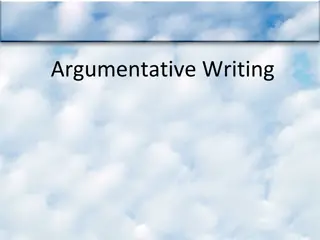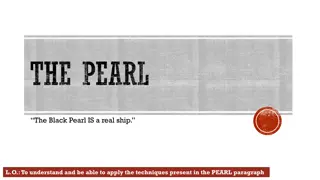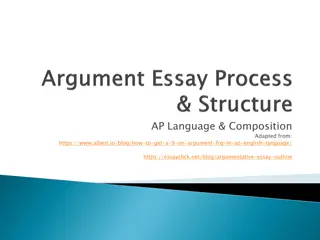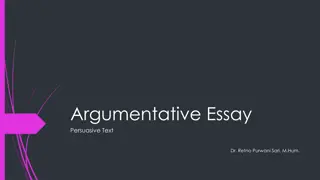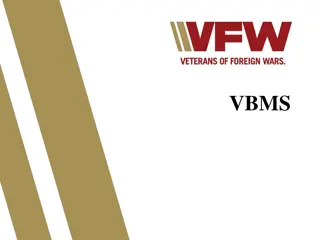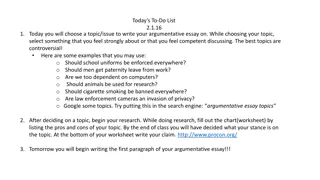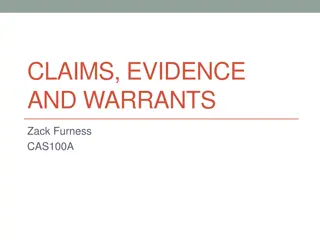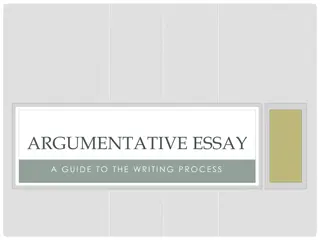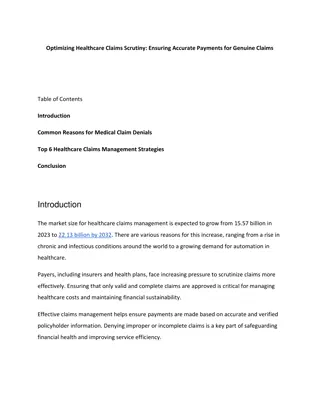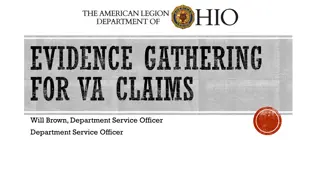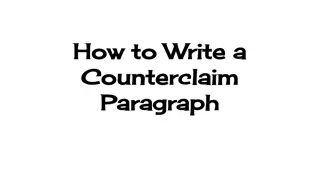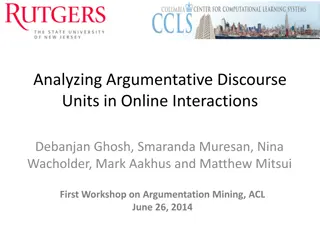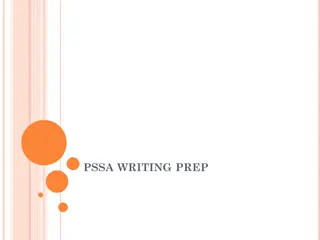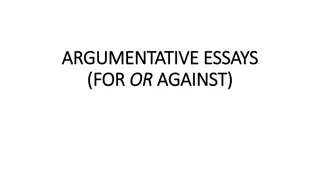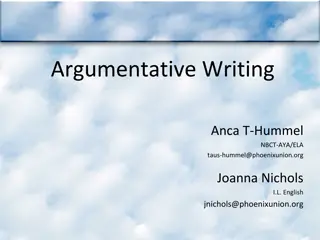Mastering Argumentative Writing: Clear Claims and Evidence
Argumentative writing involves presenting a central claim supported by evidence and logical reasoning. Learn the process from brainstorming to final draft, and understand the importance of first impressions in writing. This guide covers essential questions, steps in writing effective arguments, and the significance of clear organization when introducing and supporting claims with evidence.
Download Presentation

Please find below an Image/Link to download the presentation.
The content on the website is provided AS IS for your information and personal use only. It may not be sold, licensed, or shared on other websites without obtaining consent from the author.If you encounter any issues during the download, it is possible that the publisher has removed the file from their server.
You are allowed to download the files provided on this website for personal or commercial use, subject to the condition that they are used lawfully. All files are the property of their respective owners.
The content on the website is provided AS IS for your information and personal use only. It may not be sold, licensed, or shared on other websites without obtaining consent from the author.
E N D
Presentation Transcript
ELAGSE8W1: ELAGSE8W1: WRITE ARGUMENTS TO SUPPORT CLAIMS WITH CLEAR REASONS AND RELEVANT EVIDENCE. a. Introduce claim(s), acknowledge and distinguish the claim(s) from alternate or opposing claims, and organize the reasons and evidence logically. b. Support claim(s) with logical reasoning and relevant evidence, using accurate, credible sources and demonstrating an understanding of the topic or text. c. Use words, phrases, and clauses to create cohesion and clarify the relationships among claim(s), counterclaims, reasons, and evidence. d. Establish and maintain a formal style. e. Provide a concluding statement or section that follows from and supports the argument presented.
ESSENTIAL QUESTIONS: What is argument writing? How does it differ from other types of writing? What are the steps in the writing process? How do I write effective arguments to support my claims with clear reasons and relevant evidence?
WHAT IS ARGUMENTATIVE WRITING? The argument is a central idea, claim, or thesis/position statement. In argumentative essays, the writer will: investigate a topic collect, generate, and evaluate evidence (e.g. facts, statistics, details, quotations, etc.) establish a position on the topic in a concise manner address the opposing side
Brainstorming/Prewriting: This is the stage at which you make notes, lists, or outlines. You need to organize your major supporting details before writing the first draft. Drafting: Using your prewriting notes, write a first draft of your paper. Concentrate on getting your ideas down on paper in a logical order. Revising/Editing: Carefully reread what you have written to see if your ideas are clear and fully developed. Consider any changes that would make your paper better. Final Draft: Rewrite your paper in blue or black in and write neatly. You will have 2 pages to fit your draft. Proofreading: When you finish writing your final draft, make any needed corrections on your paper. You may strike through words as long as you do so neatly. Do not use correction fluid.
HAVE YOU EVER HEARD THE SAYING, YOU NEVER GET A SECOND CHANCE TO MAKE A FIRST IMPRESSION ? Discuss what this means? How do you think it could apply to writing?
Introduce claim(s), acknowledge and distinguish the claim(s) from alternate or opposing claims, and organize the reasons and evidence logically. INTRODUCTION AND ORGANIZATION
Grabber Quote Question Shocking Statement Onomatopoeia/Exclamation Anecdote Background information about your topic Strong position statement
at the start of the essay (use a question, an anecdote, a quote, a shocking statement, perhaps even humor). NEVER start your essay by saying Today I am going to write about the three reasons cell phones should be allowed in school. (zzzzz ..BORING!) .also at the end. Close with a bang!
sustained focus logical sequence of ideas grouping of ideas in paragraphs transitions used between sentences and paragraphs
Organize your thoughts in some type of format BEFORE you begin drafting your essay. You may want a list or a web format. It is up to you. Look at samples of graphic organizers.
EXAMPLE OF BRAINSTORMING GRAPHIC Support 1 Position Statement/ Argument Controlling idea Support 3 Support 2
NOW THAT YOU HAVE THE READER S ATTENTION, HE/SHE WILL WANT TO READ ON at this point, it is essential to provide solid reasons and evidence to support your argument.
Support claim(s) with logical reasoning and relevant evidence, using accurate, credible sources and demonstrating an understanding of the topic or text. SUPPORTING DETAILS
You will need to incorporate research on your topic as you must collect, generate, and evaluate information. Consider questions a person reading your essay might have about your position statement and/or topic sentences. Activity: For each topic sentence, develop a list of at least 3 supporting details.
You dont know who your reader is, but you want to make sure the reader can relate to your essay/writing. Reviewing and thinking about how you can use the universal reasons to prove your points is a good strategy for ensuring you have solid ideas.
Violence Self-Esteem Productivity Individuality Health (Emotional, Social, Physical) Discrimination (Sex, race, age, religion) Discipline Education Money Finances Future Safety Racism Environment Community Family Taxpayers Social Skills
on topic relevant to your position statement strong reasons to make your argument supporting ideas explained at an appropriate depth
Use words, phrases, and clauses to create cohesion and clarify the relationships among claim(s), counterclaims, reasons, and evidence. TRANSITIONS
Keep in mind that transitional words show relationships between ideas. Use them as you move from one paragraph to the next, as well as within paragraphs. Aim for use of more sophisticated transitions than First, Second, and Third. Use variety in your transitions (Improves style and organization). Complete Transition Paragraph Activity.
Establish and maintain a formal style. STYLE
Formal style means using standard English (e.g., no slang). Formal style does not mean boring. Consider your word choice. You will need vivid nouns and adjectives and strong verbs. You should include sentence variety. Awareness of audience and voice are also essential.
Unique Style Swag
Person, place, or thing Describes noun Describes how something is done
Strive to use strong verbsaction verbs which show what is going on versus always relying on dead verbs that just tell. Examples of dead verbs include: am, are, be, had, has, have, was, were, looks, sounds, feels, become, became, etc. . . . Activity: Rewrite the sentences with a partner. Show .don t just tell!
Provide a concluding statement or section that follows from and supports the argument presented. CONCLUSION
Sum up your argument Restate your topic using different words Be original End with a zinger that makes your reader think
Sentence formation (complete sentences; no fragments, run-ons or comma splices) Correct usage (subject-verb agreement, word forms, verb tense, homonyms) Correct mechanics
ADDITIONAL ACTIVITIES The following slides contain additional suggestions that a teacher may want to use depending on where the students are in the writing process. You will need to customize these ideas to fit the needs of your class.
Provide students with a sample essay. Evaluate the sample diagnostic essay. Read independently and look for: What the writer has done well What improvements should be made Use of transitions
Provide students with a topic for which they will brainstorm ideas for an argumentative essay. Students will: Work in groups of 4 or 5 Develop a position statement and a graphic organizer that includes 3 reasons and at least 2 details/examples to support each reason
Provide students with a topic for which they will write an argumentative essay. Working with a partner or in a small group, students will: Develop an introduction to the topic. Make sure you use an attention- grabbing beginning, provide background, and clearly state your position.
Now, write the conclusion to that essay. Restate your position, but remember to use different words, sum up your argument, and close with a zinger that makes an impact on the reader.


